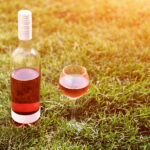
I have a tradition of opening a bottle of Billecart-Salmon Brut Rosé Champagne for my New Year’s birthday each year. The elegant bottle delivers a burst of fine bubbles and wild strawberries and orange zest on the nose and palate that add a sensuous bling to the celebration. But one doesn’t need a special occasion to drink a fine bubbly; nor do you need to spend close to $100 or more. While French Champagne may set the benchmark, many excellent sparkling rosé wines are made around the world that can be found for $35 and less.
Similarities and Differences
Like rosé Champagne, sparkling rosé wines are usually fuller and creamier in the mouth with more complexity and deep red berry aromas and flavors. It’s lush meets blush. They can be vintage or non-vintage and range from brut (dry) to sec (lightly sweet).
Champagne is only made with the three grapes grown in the appellation: Chardonnay, Pinot Noir and Pinot Meunier, using the rosé d’assemblage process. Select grapes are blended to make a base wine, and then up to 15 percent still red wine is added to enhance the color. Outside Champagne, producers can create rosé using either the saignée méthode, where the grape must (skins, seeds, juice) is macerated, or “bled,” to create the desired color, or pressée, where grapes are directly pressed, keeping skin contact with the juice. The longer must and juice remain in contact the deeper the color, as well as the aroma and flavor profile of the wine.
Both Champagne and sparkling wine undergo two fermentations. The first forms the base wine; during second fermentation, yeast and sugar are added to the base wine and sealed, allowing alcohol and carbon dioxide to form and create bubbles. Champagne is always made in the méthode champenoise (also called méthode traditionelle), with the second fermentation taking place inside the bottle for a few months or even years. The slower the process usually correlates to a finer- and higher priced- Champagne.

Sparkling rosés can be made in either the méthode champenoise or the charmat method. For the latter, the second fermentation occurs in a large closed pressurized tank, producing a sparkling wine more quickly and inexpensively. On the nose and palate, the bubbles feel plumper and fruiter with carbonic maceration sparkling wine and smaller and more subtle under the traditional method. What you prefer is a matter of taste. There is a place at the table for both styles.
Regions of Note: Wines Made in the Méthode Traditionelle
Sparkling rosés can be made anywhere in the world. Some regions specialize in their production. The Loire Valley is second only to Champagne in sparkling wine production in France; one to try is Volage Crémant de Loire Brut Rosé made from 100% Cabernet Franc ($29). Other regions in France making sparkling crémants including Alsace, Bordeaux, Burgundy, Jura, and Limoux ( Languedoc-Roussillon) and Die (Rhone)
Cavas, produced exclusively in the D.O. Penedès region of Spain, are all made in the mêthode traditionelle. Most are made with the native Trepat and Garnacha grapes, but can also use international grapes. They tend to be rosier in color and fruitier on the palate; think red currants, pomegranate and ripe strawberries. Two offering quality for value are Segura Viudas Brut Rosé NV ($12) and Cavas Hill Cuvée Panot Rosé NV ($14).
While many styles of sparkling wine are made in Italy, two regions that focus on the “metodo classico” are Franciacorta D.O.C.G. and Trento D.O.C. Good examples are Cantadi Castaldi Brut Rosé Franciacorta D.O.C.G. ($26) and Ferrari Brut Rosé, Trento D.O.C. ($34). Further abroad, try South Africa’s Graham Beck Sparkling Brut Rosé, ($14). California is home to several excellent sparkling rosés. Two under $25 include Scharffenberger Brut Rosé ($22) and Roederer Estate Brut Rosé ($28)
Pairing with Food

The roundness, complexity and balanced acidity of sparkling rosés make them versatile food partners throughout a meal rather than just sipped as an apéritif. My favorite pairings are with salmon, either smoked or herb-roasted, and spicy dishes like Cajun jambalaya and Moroccan tagine. These are wines that can take you through to dessert; think fresh berries with sabayon crème.
I asked three beverage experts to recommend pairings with wines for $35 or less.
Master Sommelier Virginia Philip, Beverage Director for The Breakers Palm Beach and owner of Virginia Philip Wine Spirits & Academy, suggests:
JCB No 69 Crémant de Bourgogne ($26) – “This is a hands-down favorite and we sell quite a bit. It pairs well with jambón, lighter cheeses, tuna or salmon tartare and tomato quiche.”
Gracida Rosé Frizzante D.O. La Mancha ($18) – Named after one of the world’s most awarded polo players, Carlos Gracida, “this wine has a slight residual sugar and is light and very easy to drink. Oysters, mussels with curry and duck confit all pair nicely.”
Marika Vida-Arnold, Owner of Vida et Fils Wine Consulting and former Wine Director for The Ritz-Carlton New York, Central Park recommended:
Juve y Camps Rosé, Cava – 100% Pinot Noir ($17) “It’s floral and fruit-driven with a slight smoky almond character. Pair with smoked salmon blini with crème fraiche.”
Vajra Della Neve Rosé Brut NV, Barolo – ($35) “A 50-50 blend of Nebbiolo and Pinot Noir made in the metodo classico style, this fragrant, mineral- driven rosé is bone-dry, subtle and elegant. A classic pairing of what grows together goes together is regional salumi and cheese.”
Scott Beattie, Beverage Director, Estate Events at Meadowood Napa Valley:
West + Wilder Sparkling Rosé – ($18/3 pack can). A beach-ready canned wine from Sonoma, Beattie said it offers great taste with value. “Try with gougères, crispy chickpeas with ginger and turmeric, smoked trout and mussels with cream and tarragon.”
Domaine Allimant-Laugner Crémant d’Alsace Rosé – ($28). In addition to world-class Rieslings, Alsace produces elegant cool-climate Pinot Noirs. Crémant d’Alsace is one of the oldest and most widely consumed sparkling wines in France. Beattie said, “Enjoy with crudités with Greek yogurt sprinkled with bee pollen and Piment d’Ville [a peppery spice made in California, also common to the Basque region of France].”
Why stay still when you have a little sparkle? With so much versatility pairing with food and a pleasant burst of flavor on the palate, sparkling rosés deliver style, quality and value for any occasion or time of year.
Wine4Food Recommends
Castello delle Regine Brut Rosé
Cave de Ribeauville Cremant d’Alsace Rosé
Negri Menalca Spumante Brut Rosé

Melanie Young co-hosts the national weekly radio show, The Connected Table LIVE! Wednesdays 2 pm EST on W4CY Radio and podcast permanently to iHeart.com and the free iHeart App.



